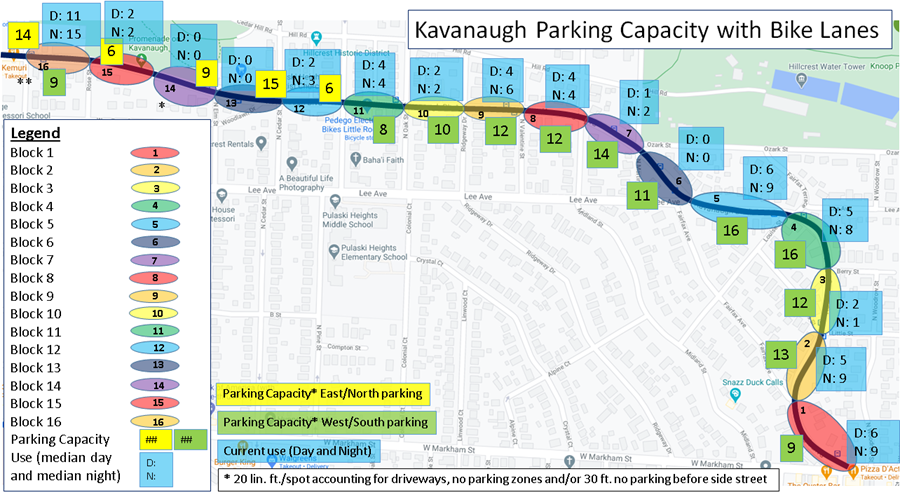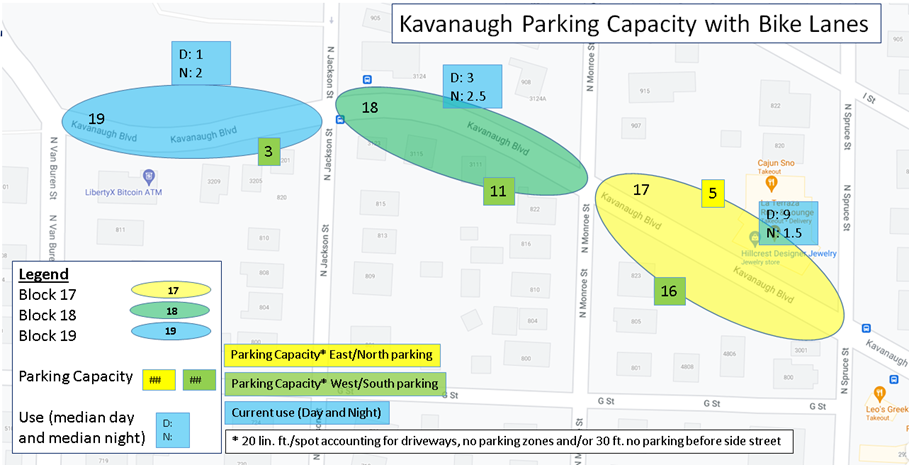Costs
Monetary Cost
This project is part of a resurfacing project. To maintain the street, the City periodically removes and replaces the top layer of asphalt. Afterwards, striping must be reapplied. Because this redesign would follow resurfacing, it is no more expensive than retaining the current lane configuration, i.e. there is no significant monetary cost.
Parking Capacity Cost
The main cost of this project is the loss of parallel street parking on the north side of the street. This may require residents to cross the street to access their vehicle or house. However a corridor parking study assessing parking use on each block with ~70 day and night, weekday and weekend observations shows that bike lanes will not reduce parking capacity below use for any altered block (Figs. 1 and 2). See also raw data for Kavanaugh daytime and nighttime parking.

Figure 1. Parking capacity (green and yellow) on Kavanaugh between Markham and Walnut with buffered bike lanes as currently proposed.

Figure 2. Parking capacity (green and yellow) on Kavanaugh between Markham and Walnut with buffered bike lanes as currently proposed.
Other Costs
Residents on the north side of Kavanaugh who parallel park on Kavanaugh will have to cross the street in order to access their car. Protected bike lanes would change Kavanaugh's aesthetic.
- Government
- Employment
-
Residents
- Citizen Services & Helpful Numbers
- 311
- Animal Services
-
BikePed Little Rock
- Why BikePed?
- Contact BikePed Little Rock
- Education
- Resources
- ATAC
- BFC Bronze June 2020
- BFC Bronze May 2016
- Complete Streets Policy Among Best of 2015
- BikePed Count
- Community
- Evaluation
- What Can I Do?
- Projects
- Complete Streets Master Plan
- Board of Directors - Meeting Agendas
- FAQs: General
- Little Rock Identification Card
- Little Rock Marathon
- Online Payments
- Parks and Recreation
- Police Department
- Recycling
- Solid Waste Pickup
- Title VI Complaints
- District Courts
- Zoo
- Volunteer
- Flood Information
- Sustainability
- Business
- E-News
- City News
- Online Payments




 Trash & Recycling
Trash & Recycling
 Online Payments
Online Payments
 City Documents
City Documents
 Parks
Parks
 Traffic Court
Traffic Court
 E-NEWS
E-NEWS
 EXPLORE
EXPLORE
 NEWS
NEWS
 TRANSLATE
TRANSLATE
